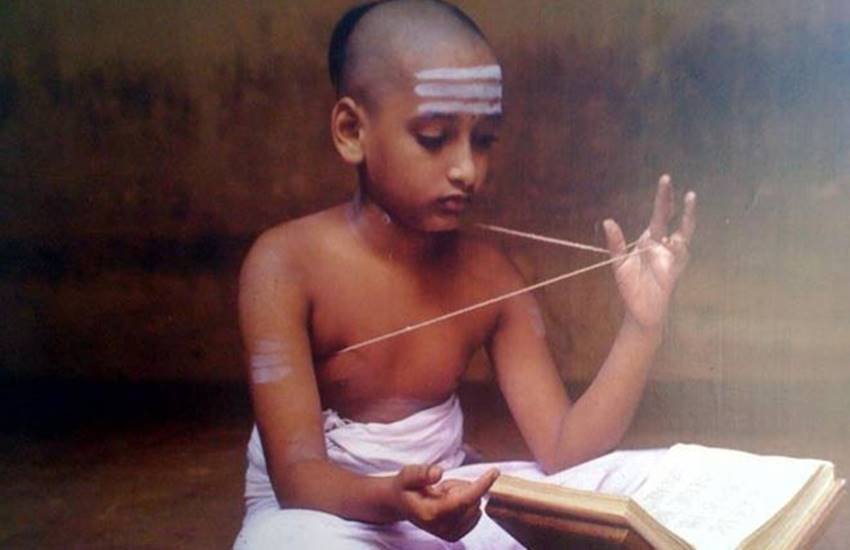Well, in the following excerpt you would know the real meaning and purpose behind Hindu rites and rituals. You would also know why we do things in a particular way and the scientific fact behind it. So hold tight and enjoy with us on our journey of exploring a minute detail that of ‘janeyu’ with us. So, Why Do Hindus Wear Janeyu?
What Is A Janeyu?
Well, a Janeyu is a string made up of several consecrated threads. Then the orthodox males such as Hindu Brahmins, Kashtriyas and Vaishyas wear them. However, the type of janeyu differs from caste to caste and community to community. Talking of Brahmins, Kashtriyas and Vaishyas, they wear threads made out of cotton, hemp and wool, respectively.
The Sacred Thread Ceremony – Why Do Hindus Wear Janeyu?
There is a ceremony that has a different name in India. It is the upanayana samskara ceremony. One usually observes this between the ages of seven and fourteen. Also, in case the ceremony does not take place due to some reason during this period, then one performs it before the marriage of the individual.
The main purpose of this ceremony is to prepare a young man to share the responsibilities of his elders. A male wears the thread in the company of a group of Brahmins chanting the Gayatri Mantra. One twists the thread in an upward direction. The ceremony says that the wearer of the janeyu can hereafter actively participate in family rituals.
Brahmins use a janeyu with three strands. And these three stands stand for the Hindu trinity of Brahma, Vishnu and Mahesh. Others interpret it as the symbol of Mahasaraswati, Mahalakshmi and Mahakali. Yes, that’s true! Many people have a belief that it relates to the past, present and future. Out of all such opinions, the aptest is that the three strands stand for ida, pingala and sushumna nadis. This is through which the kundalini shakti or hidden energy operates in a human body.
How Is It Made? – Why Do Hindus Wear Janeyu?
A janeyu is generally made up of pure cotton strands. And did you know that cotton seeds have seven layers? Yes, that’s right!
In a human body to there are seven sheaths and also seven chakras. Therefore, pure cotton is spiritually compatible with the human body. This, however, isn’t a statement via contemporary science. Before being worn, one must charge the janeyu with appropriate mantras. One must further sanctify it by applying sandalwood paste. And that’s not it, one should also soak it in unboiled cow milk. Such a janeyu works on a person as an antenna to receive divine vibrations. Isn’t that amazing? Particularly when one maintains it via following the given instructions and code.
The Ayurvedic Way
According to Ayurveda, there is a nerve called lohitika. This lohitika goes to the urinary tract and passes through the region of the right ear. When one slightly presses this nerve, the urinary track opens easily. This is the exact moment when the person can pass urine fully, thus throwing out toxins from his body.
For this reason, Hindu males wind up the janeyu over their right ear to press this nerve while urinating. The lohitika, the nerve is also a connecting part to the testicles and helps in checking hernia.
Science Behind Wearing Janeyu – Why Do Hindus Wear Janeyu?
Incidentally, modern doctors pierce the right ear lobe to check the growth of hernia in a man. This is one way of doing it. Thus, one can safely say that there are scientific reasons behind wearing janeyu.
Orthodox Hindus wear the janeyu on the left shoulder. It has six holy threads for a married man and three for a brahmachari or bachelor. So make sure you know who you’re preparing for. In the south, one discards old janeyus and new ones are worn on the shravana purnima, while chanting the Gayatri Mantra.
Similarly, following birth or death in the family, one removes the janeyu. One also replaces it with a new one after thirteen days of the event. This is done because the janeyu is not any ordinary thread in the market that you see. Well, one can disturb it’s sanctity if it is not worn properly or if even one changes on the occurrence of some inauspicious event.
On the same note, Hindus, Parsis too wear the kusti around their waist, which symbolizes the tenets of their faith. A kusti is woven with seventy-two threads of fine lambs’ wool. Yes, you heard that right! The number of threads denotes the chapters in the Yasna, the Parsi book of worship. Isn’t that wonderful?








